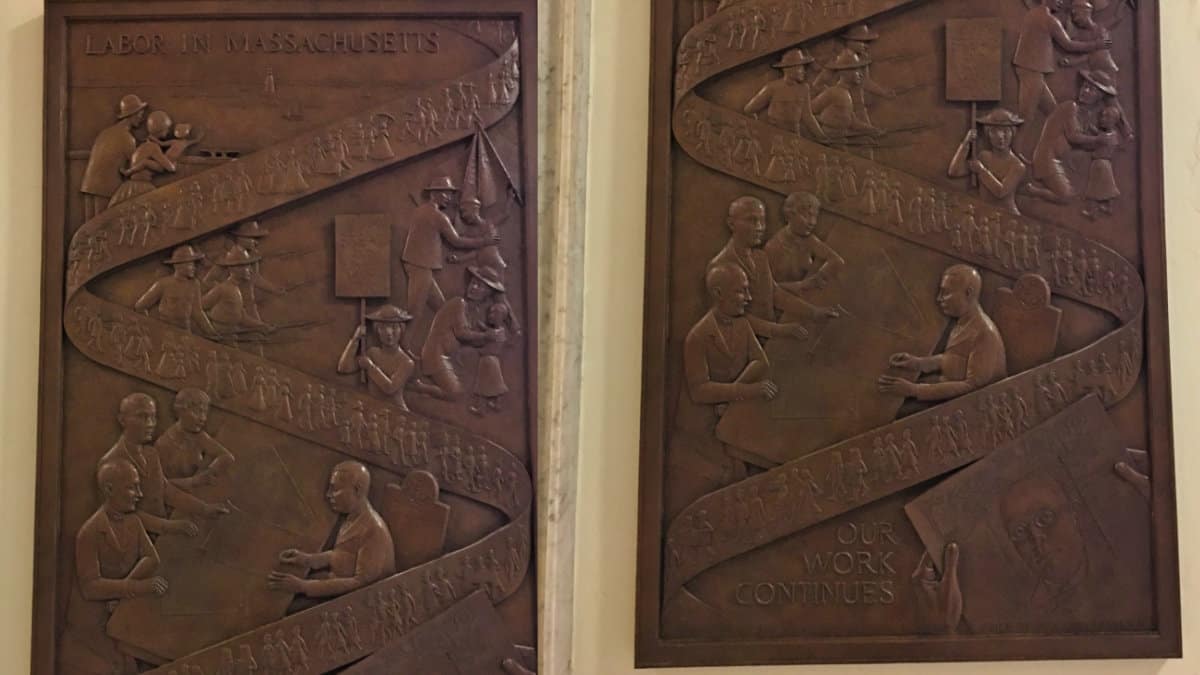
Ayer Mansion
Take a tour of the Ayer Mansion for some artistic Boston history
On Commonwealth Avenue, there are a lot of special homes. The Ayer Mansion is one such place that is overlooked by tourists.
Tours of the home are available on very limited bases. They are held one Saturday and one Sunday a month. Visit their website for tour dates and time.
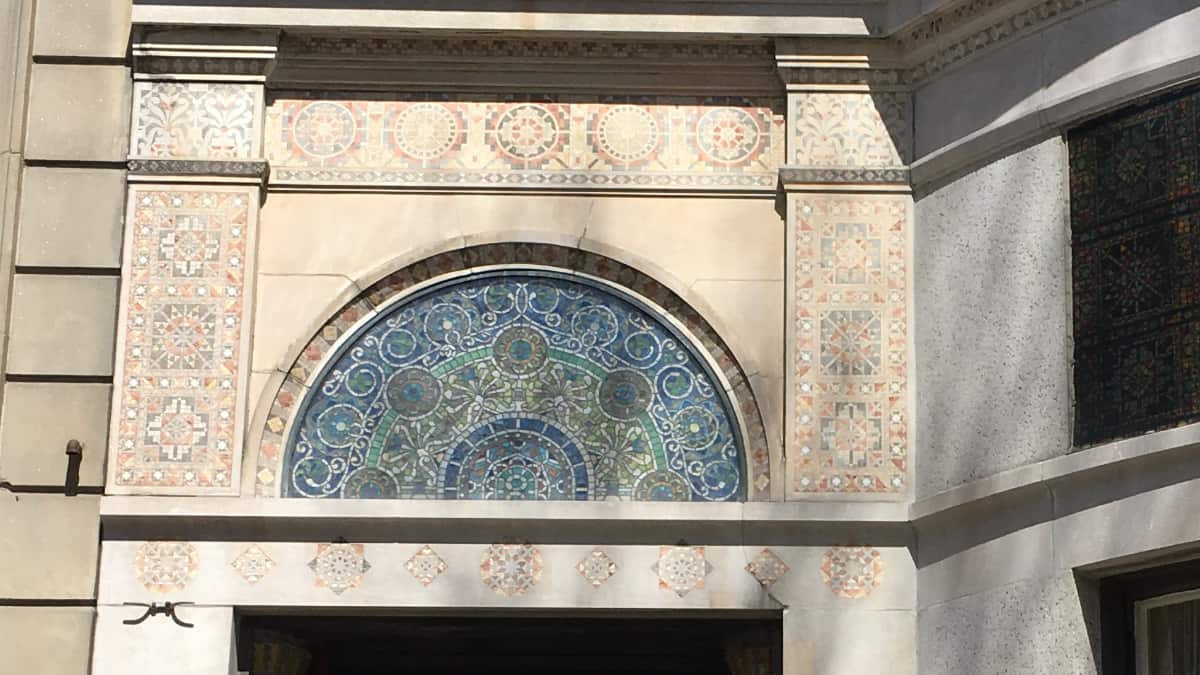 The stain glass above the door at the Ayer Mansion
The stain glass above the door at the Ayer Mansion
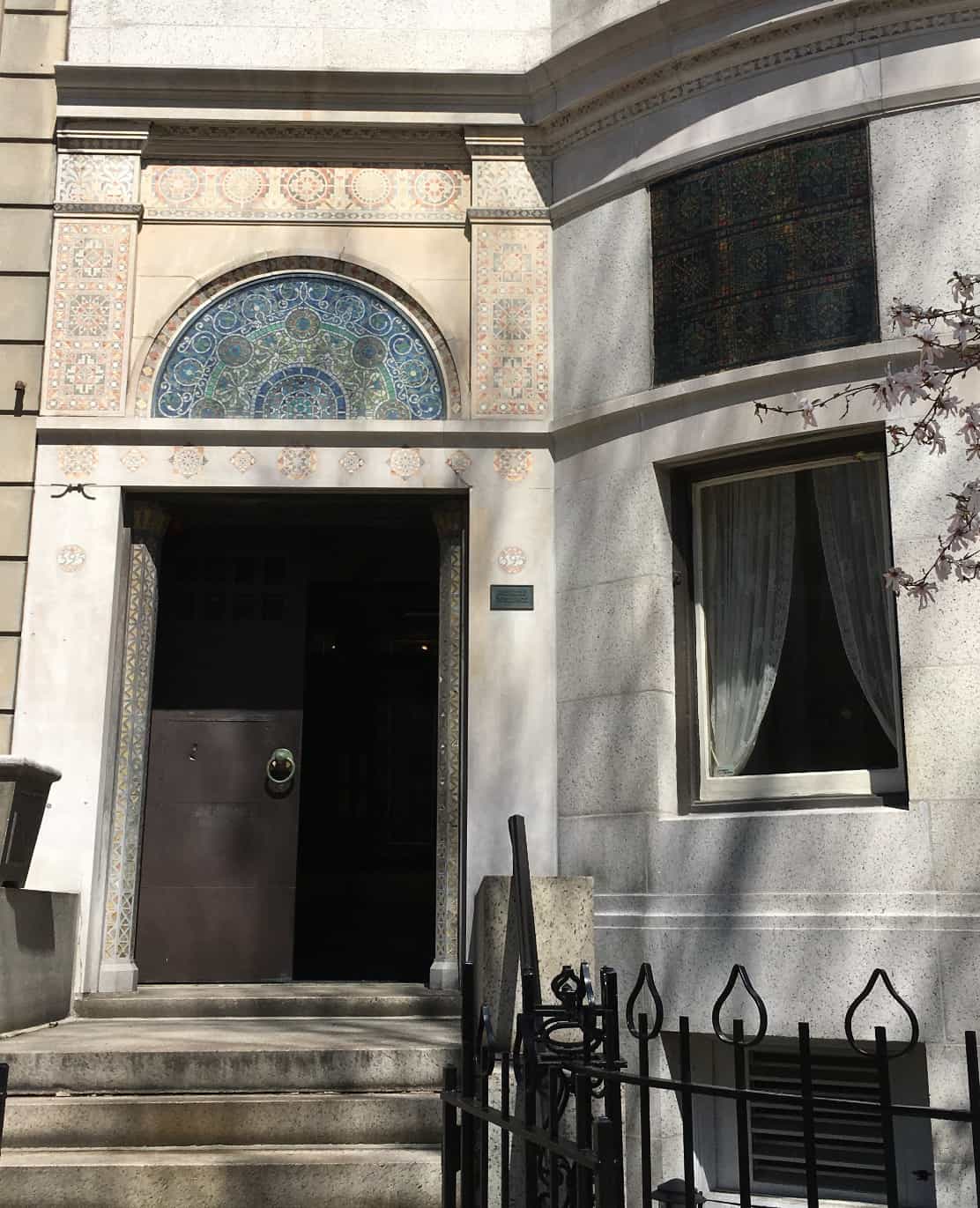 The stain glass above the door at the Ayer Mansion
The stain glass above the door at the Ayer Mansion
Five Things I learned
- The house was built between 1899 - 1902 for patent medicine and textile entrepreneur Frederick Ayer. It was designed by Louis Comfort Tiffany.
- The Ayer Mansion sole example of a house designed from its inception by??[Louis Comfort Tiffany](http://www.biography.com/people/louis-tiffany-9507399). This is the only surviving house over which Mr. Tiffany had complete control, which allowed him to integrate themes and details both inside??and outside.
- Listed on the National Historic Mansion. This is the only house on CommmonWealth Ave that is listed on the National Historic Landmark.
- When Ayer died in 1918, at the age of 95, the Boston Globe described him as New England???s richest man, and the New York Times sketched his rise from a poor shopkeeper to a titan of industry.
- There is a missing Tiffany Vase from the Ayer Mansion. It may have been missing for decades and a collector may have it without knowing that it is stolen from the Ayer Mansion. The vase is supposed to be in the hands of a Tiffany collector from the MidWest. The Ayer Mansion preservation believes the previous owner of the house took it when it was sold in 1964.
Finding The Ayer Mansion
The Ayer Mansion is located at 395 Commonwealth Ave - between Massachusetts Ave and Charles Gate East.
YouTube Tour
Someone that took the tour in 2018 recorded it. It might be interesting to watch to learn more about the house and a chance to see the inside.
PermalinkEmancipation Group
Facts about the Boston Statue people suggest to take down
There has been a lot of talks lately of a famous Lincoln Statue near the Boston Commons. This statue featured President Lincoln and a slave.
Many people think the statue is racist and suggest taking it down.
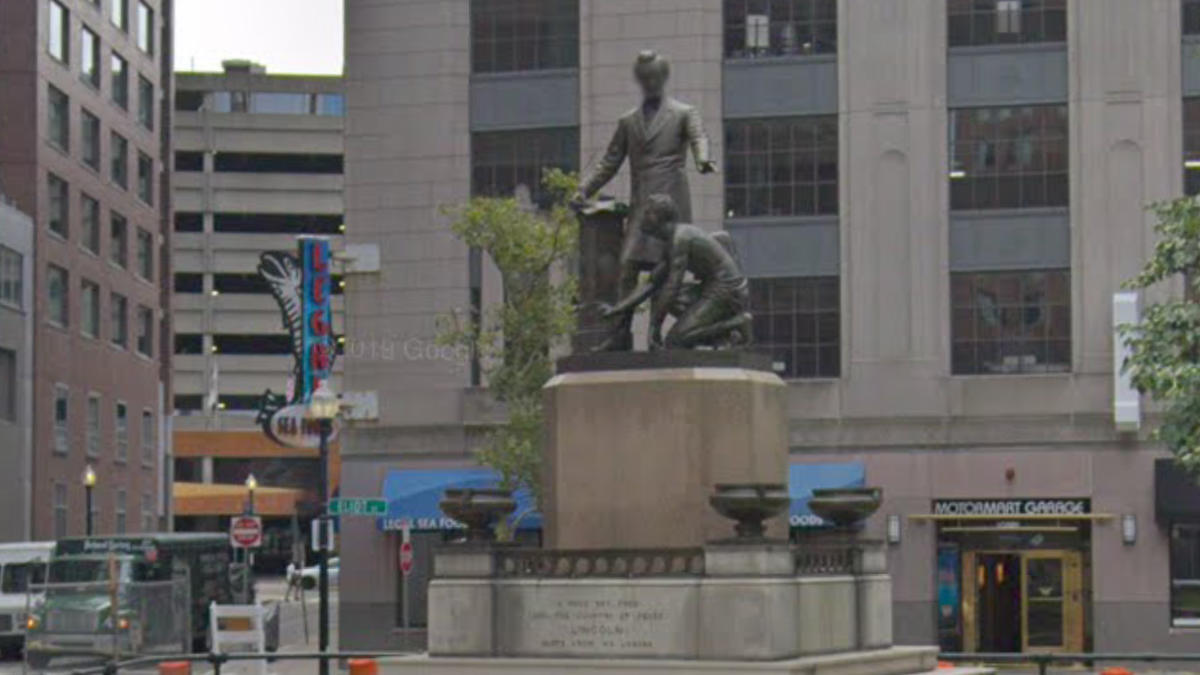
Emancipation Group Statue (Courtesy of Google Maps)
Note: I don't have a personal picture in my collection and resorted to a picture on Google Maps.
Four Things I Learned
The official title of the statue is: Emancipation Group
Statue was created by Thomas Ball. He created many other statues in Boston such as the Equestrian Statue of George Washington, Josiah Quincy, and Charles Sumner.
Statue was created in 1874
This casting of the Emancipation Group the City of Boston in 1877 by Moses Kimball of the Boston Museum.
The head of the slave is modeled from a photograph of Archer Alexander, the last slave to be recaptured in Missouri under the Fugitive Slave Act.
The original casting of the statue is in Washington DC. It was commissioned by the Freedman's Memorial Society in Washington D.C. It cost $17,000 ($389,462.51 in 2019) raised by Washington D.C. black community.
Charlotte Scott, a former slave from Marietta, Ohio, gave the initial donation of five dollars - her first earning as a freed person to help commission a statue for Lincoln.
A plaque near the statue in Washington DC reads: "Freedom's Memorial, in Grateful Memory of Abraham Lincoln: This monument was erected by the Western Sanitary Commission of St. Louis, MO, with funds contributed solely by emancipated citizens of the United States declared free by his Proclamation January 1, A.D. 1863. The first contribution was made by Charlotte Scott, a freed woman of Virginia, and consecrated by her suggestion and request on the day she heard of President Lincoln's death"
The statue in Boston was last restored by the Boston Park Plaza Hotel and Towers.
Staute Resolve and Order
The City of Boston resolve for the statue in 1879:
Whereas, a communication has been received from Hon. Moses Kimball, in which he tenders to the City of Boston the gift of a colossal group in bronze, emblematical of Emancipation, upon conditions that it be placed upon the lot of land at the junction of Columbus Avenue, Park square and Pleasant street, and that the city will cause the area to he suitably enclosed and annually cultivated with flowering plants and shrubs; it is therefore hereby
Resolved, That the thanks of the City Council, in behalf of the citizens of Boston, be conveyed to the Hon. Moses Kimball for the public spirit displayed in his costly and substantial gift to the city, which is hereby gratefully accepted upon the conditions attached to his offer.
Ordered, That the triangular lot of land situated at the junction of Columbus avenue. Park Square and Pleasant street be and the same is hereby assigned for the location of the group.
Ordered, That the Committee on Common and Public Grounds be requested to take such action as may be necessary to cause the said lot to be put in order and enclosed with a suitable fence, in accordance with the terms of the gift.
PermalinkQueen Elizabeth II Plaque
Queen Elizabeth II visited Boston in 1976
In Boston's Old North Church, there is a plaque to commemorate when Queen Elizabeth II said a prayer during her visit to Boston in July 1976.
Thousands of people came to watch the Queen visit sites around Boston on her Bicentennial visit to the United States.
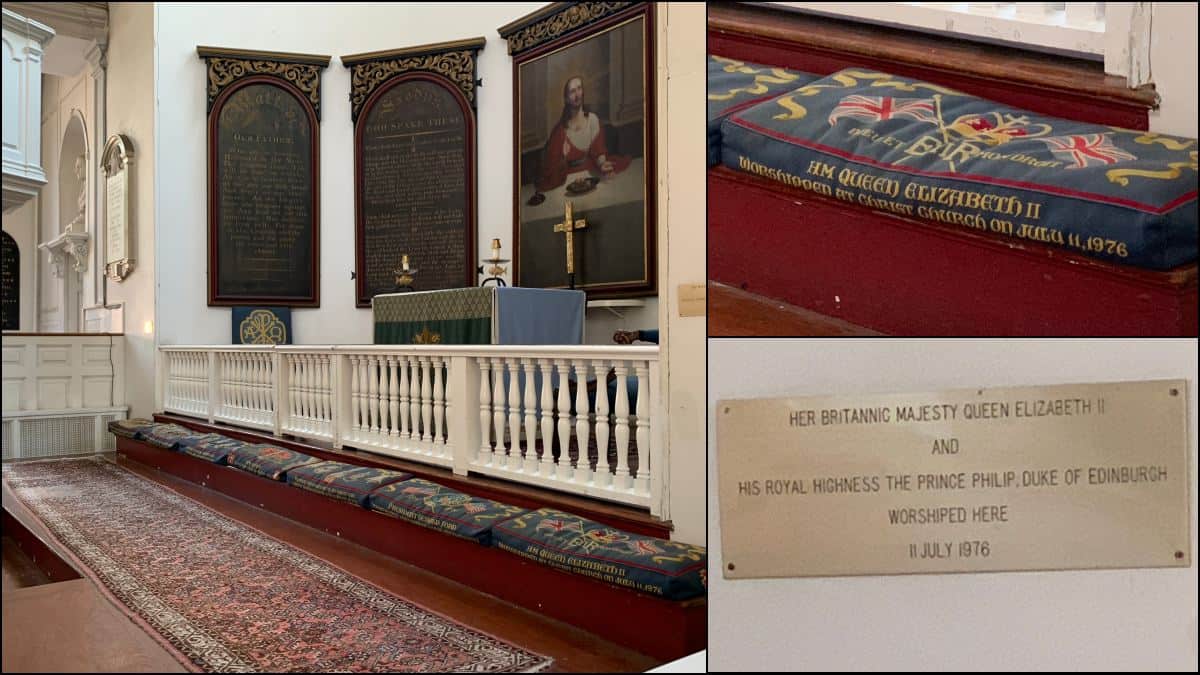
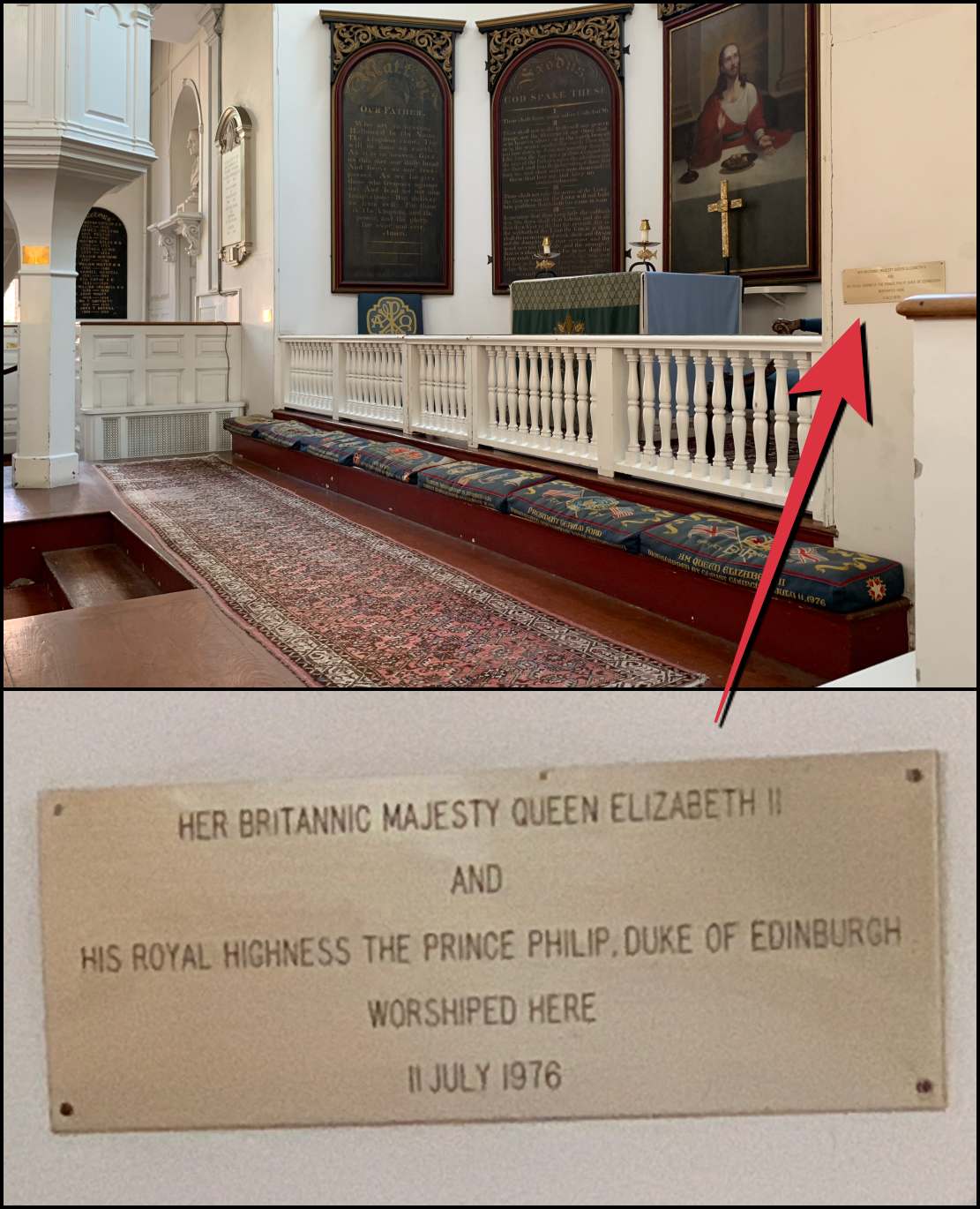
Fun Facts about the Queen's Visit to Boston
Queen Elizabeth, Prince Philip, her Mistress of the Robes, her Lady-in-Waiting, her Equerry-in-Waiting, her secretaries - a total of 52 arrived in Boston on July 11, 1976. She arrived on her royal yacht HMY Britannia escorted by the USS Constitution.
The Queen's visit to Boston was the first time a reigning monarch visited the city of Boston.
Prince Philip and Queen Elizabeth first stop was a morning prayer at the Old North Church.
At the Old North Church on April 19, 1975, President Ford lit a third lantern dedicated to America's third century of freedom. Upon seeing the lantern, the Queen remarked, "May the light never be dimmed."
After the Church they headed over to the Old State House where 200 years earlier the Declaration of Independence was read to the citizens of Boston.
Queen Elizabeth was quoted saying, it was here "that it all began."
The queen was dressed in a white and red print dress and a white and red straw hat.
They started the historic Bicentennial visit in Philadelphia on July 6 on her boat the Britannia. She attended a state dinner at the White House, toured the nation's capital, spent a day in New York, visited Thomas Jefferson's home near Charlottesville, and had a special dinner party on the Britannia in Newport Rhode Island. Boston was the last stop on her Bicentennial visit to America.
The queen was given a tour of the city by Gov. Michael S. Dukakis and Boston's Mayor Kevin H. White.
She left Boston late in the day on the HMY Britannia heading North to Nova Scotia.
PermalinkAlexander Hamilton Statue
Fun Facts about the Alexander Hamilton Statue
Alexander Hamilton was a politician, military commander, banker and one of the founding fathers of the United States. He was the first Secretary of the Treasury. During the five years in office he help built the foundation that is still being used today.
Many Bostonians felt a statue was needed so that people would always remember his contribution to the country.
The statue was put up four years before the Equestrian Statue was put up at the Boston Public Gardens.
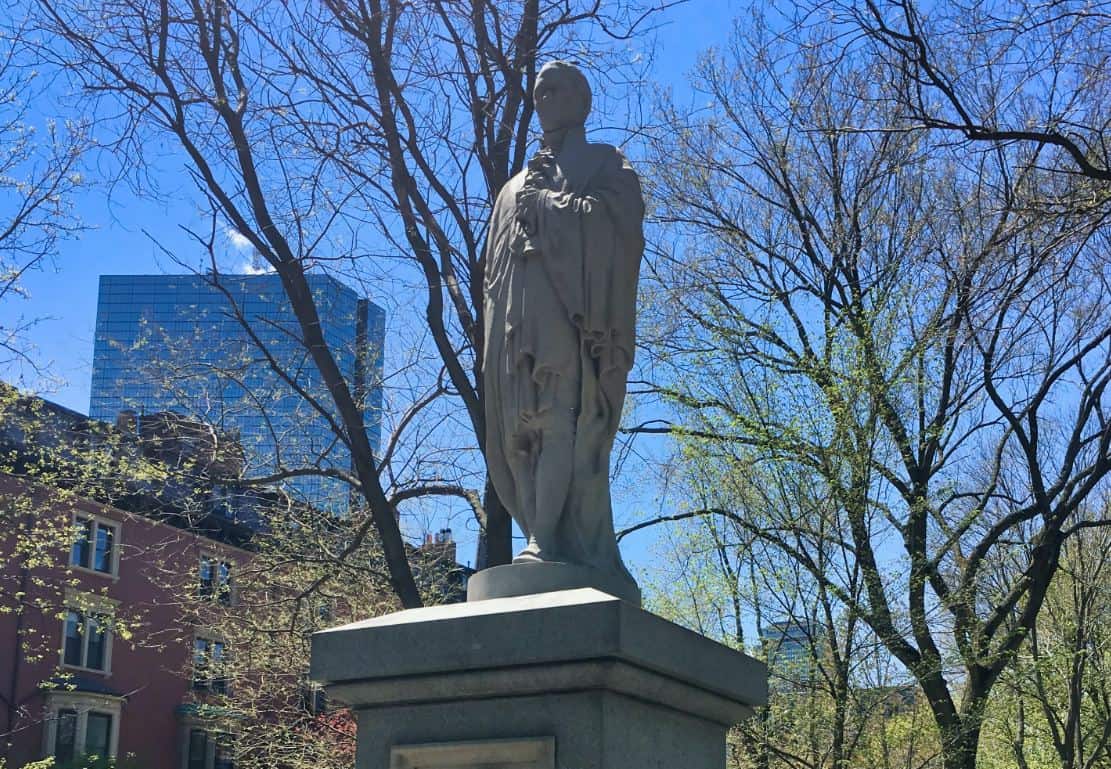
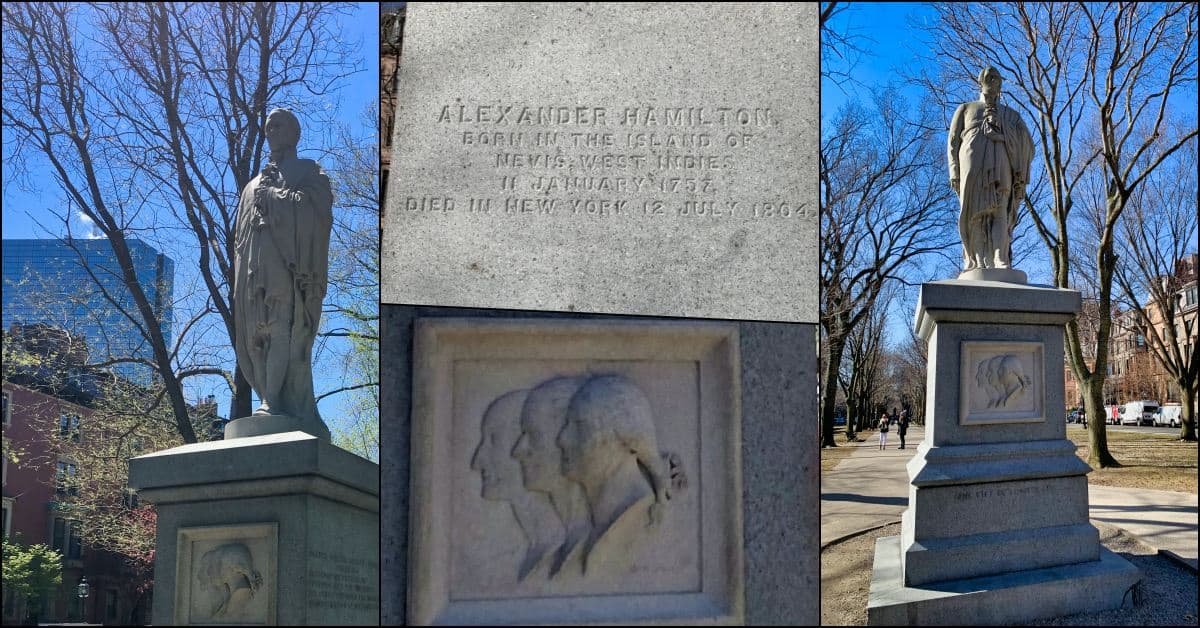
Six Things I Learned
- Placed on the pedestal on Commonwealth Ave on August 25, 1865. There was no formal inauguration ceremony. The statue was put up 61 years, 1 month, 13 days after he died.
- Created by William Rimmer based on the bust of Alexander Hamilton by Giuseppe Ceracchi which is located in the Boston Athenaeum. The bust was done in 1791.
- Made with Quincy granite. (Some media report at the time had Carlisle granite or Concord, NH granite.)
- There are three portraits on the base showing Hamilton, John Jay and George Washington.
- The statue was paid for by Tomas Lee, a wealthy merchant. It is maintained by the Public Park commission.
- At one time there was a small fence around the base, then there were some bushes. Today the base has simple stones.
Works Cited
"MEN ON THE MALL."??Boston Globe (1960-1988),??Oct 04 1970, p. 5.??ProQuest.??Web. 4 June 2020??.
PermalinkEdward Cohen Plaque
Special Plaque in the State house took nearly 100 years to be placed
In the Executive Wing of the Statehouse there is a plaque remembering Edward Cohen's contribution to the labor movement in Massachusetts.
In the 222 years of the Massachusetts Statehouse, there has only been one reported fatality - Edward Cohen. He was a labor leader who was shot in the head as the assassin mistaken him for the Massachusetts Governor.
In 1907, Edward Cohen was the president of the American Federation of Labor and he worked hard to protect children's labor rights.
According to local reports:
On the afternoon in December 5th, he was waiting in the Executive Office waiting to meet Governor Curtis Guild Jr. John Steele came bursting in the room and started shooting around. Bullets flew all over the room hitting the walls and furniture. Two bullets ended up hitting Edward Cohen and Dennis D. Driscoll - another labor leader in the room.
Arthur M. Huddell, president of the International Union of Operating Engineers attacked John Steel and held him until police arrived.
A couple of days later, Edward Cohen was pronounced dead at Massachusetts General Hospital.
Dennis Driscol recovered from his injuries - it took about two months. His first visit after recovering was the State House. A few years later he became the Deputy Institution Commissioner. A public testimonial fund was set up and $10,000 was raised.
John Steele was committed to Bridgewater State Hospital. He was 38-years old at the time of the shooting. There isn't anything else about his life after that.
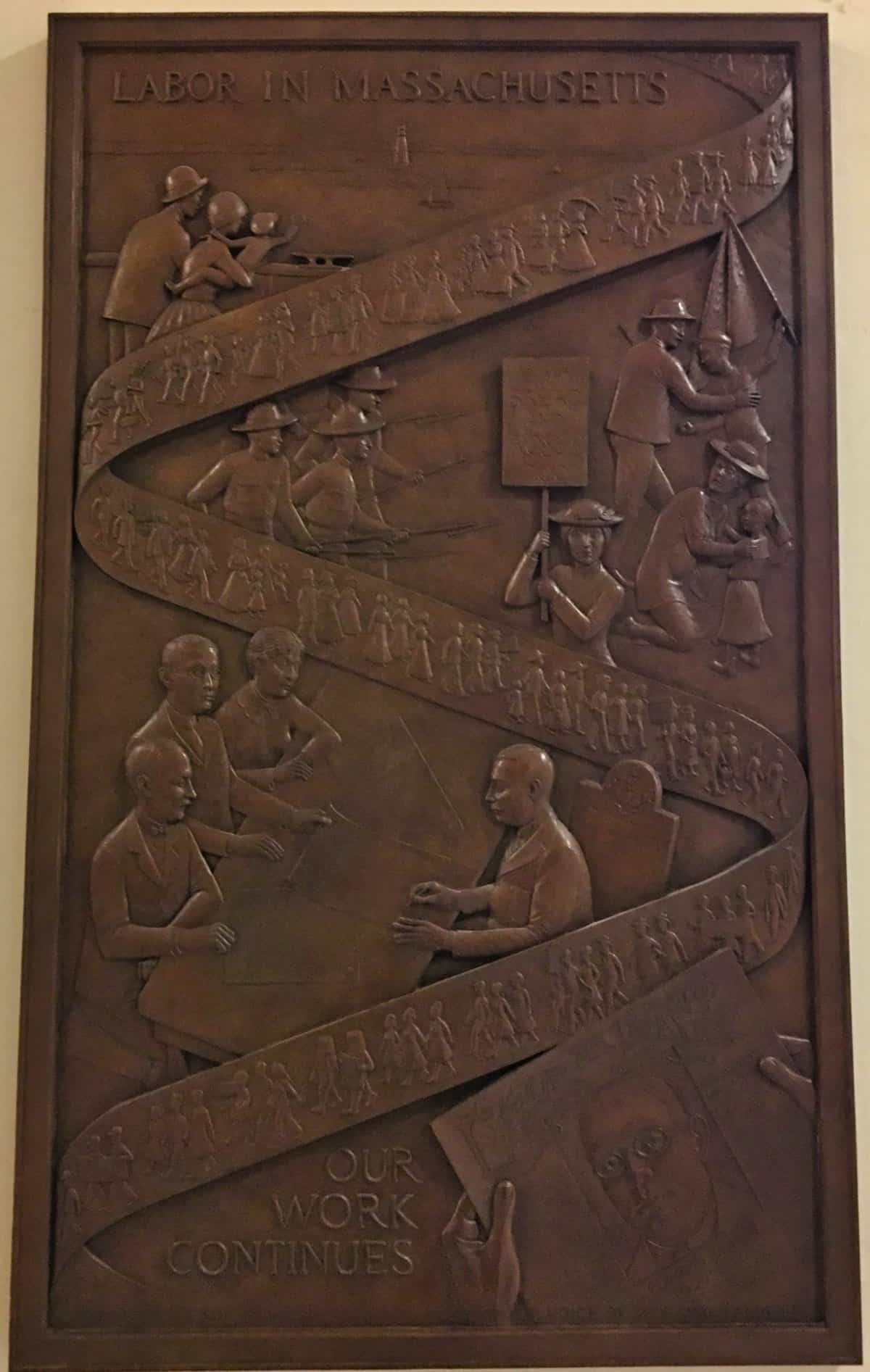
Six Things I Learned
- Representative Steven M. Walsh sponsored a bill for the plaque. The bill was sign into law on the last day of Governor Jane Swift term.
- Created by Meredith Bergmann
- Installed on October 4. 2009 near the speaker of the house office.
- There are three newspapers on the plaque, these are the headlines:
- 1911 - "The Commonwealth of Massachusetts An Act Related to Employee Injuries"
- 1913 - "The Commonwealth of Massachusetts An Act to regulate Labor of Minors"
- 2006 - "The Commonwealth of Massachusetts An Act Increasing the Minimum Wage"
- The sign that the girl is holding says: "We Want Bread and Roses too" - a reference to the slogan that was used during the textile strike in Lawrence, Massachusetts in 1912.
- Bottom of the Plaque reads, "Dedicated to the Massachusetts AFL CIO in Voice of Working Families." This is hard to read while looking at the plaque.
Boston Guide Sign
A sign at Park Street Station helps you get around Boston
Boston is a confusing city to travel around. It can be hard to know which train to take to go to some popular locations.
For example, which Green Line train should you take to get to Fenway Park? What's the best train to the Theater District?
At the Park Street MBTA station, there is a cheat sheet sign on which train to take to many popular destinations.
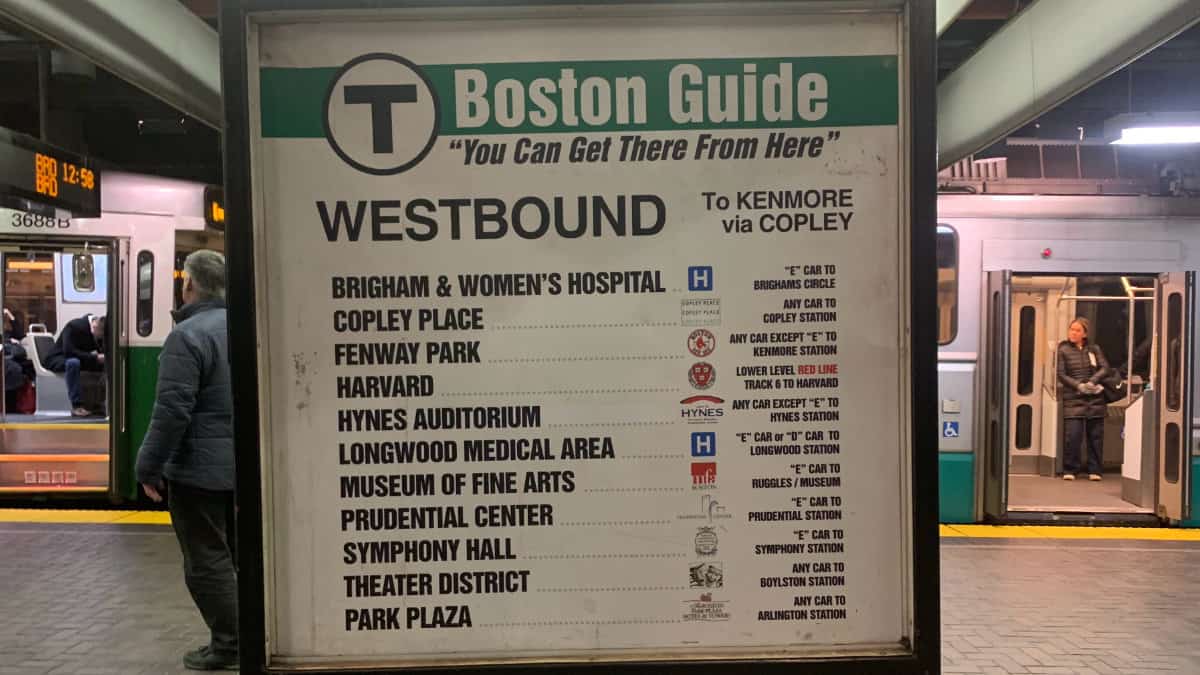
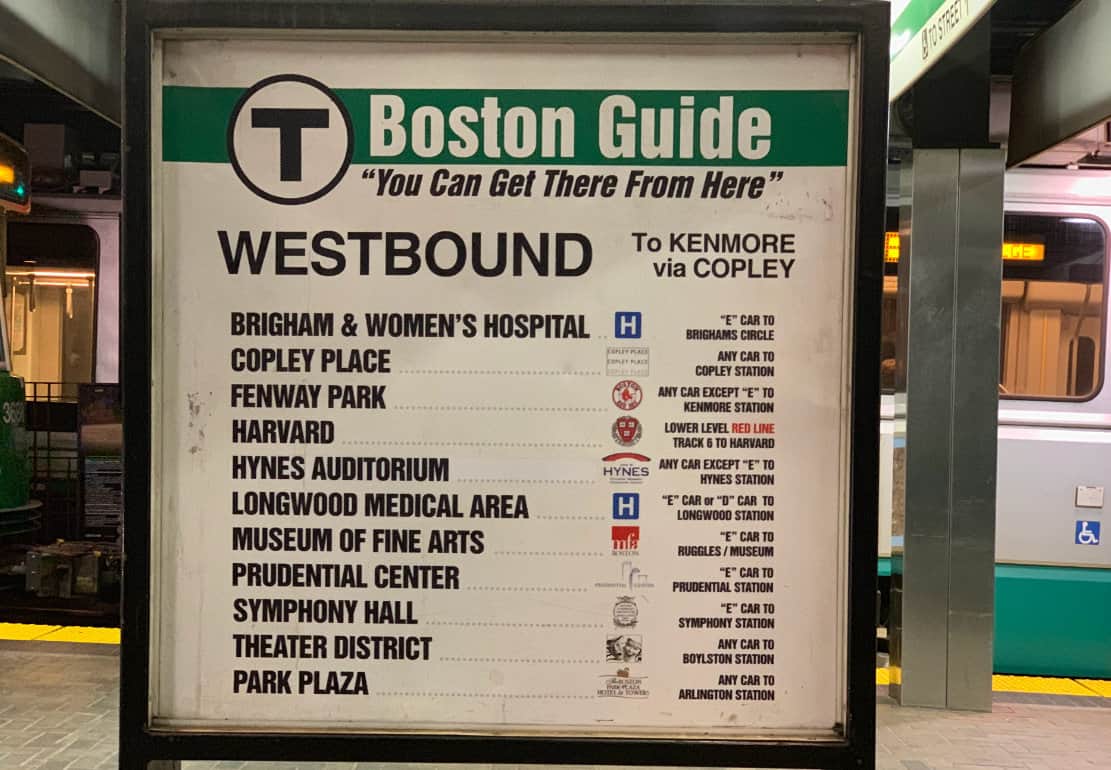
Not Available in All Stations
I haven't seen similar signs in other MBTA stations. All the stations have maps to the various MBTA stops, but only the Park Street station has a guide to popular destinations.
PermalinkMary Chilton Tablet
Tablet show the location of a Pilgrim House in Boston
Near the corner of Devonshire Street and Spring Lane is a tablet for Mary Chilton. She was a passenger on the Mayflower that later moved to Boston.
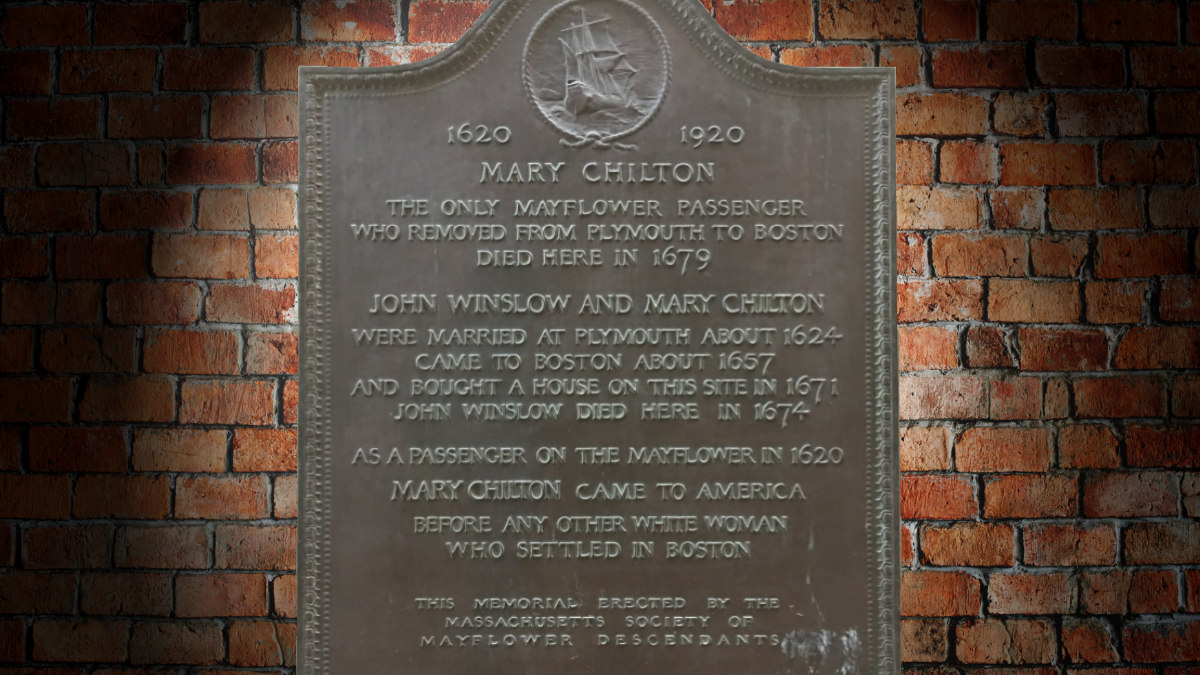
Five Fun Facts About this Tablet
The tablet was unveiled on October 23, 1924. Arthur Winslow, the ninth in descent from John and Mary Chilton Winslow did the unveiling.
The tablet was made by John F. Paramino - he did many sculpture work around Boston. Commodore John Barry Monument, The Declaration of Independence, Founders Memorial, World War 2 Memorial and many others.
THe tablet is 35" in height and 30" in width.
The tablet was placed and paid for by the Massachusetts Society of Mayflower Descendants
After the tablet unveiling ceremony the program continued at the Old South Meeting House, just a few blocks from the Mary Chilton lived. The Old South Meetinghouse is the only Boston Church to have the honor of having a Mayflower passenger as a member. (The Old South Meeting House was actually built 50 years after her death.)
Four Fun Facts About Mary Chilton
She is believed to be the first settler to touch Plymouth Rock. There are
Born on May 31, 1608, in Sandwich, United Kingdom. Her father died when the Mayflower was anchored in Provincetown Harbor and her mother died shortly after.
There is a tomb in Kind Chapel Burying Ground that has the names of John and Mary Chilton Winslow. However, George Ernest Bowman, the secretary of the Mayflower Society in 1924, has publicly stated that there's no conclusive proof that Mary Chilton. (Even the Pilgrim Hall Museum says, "THey may be buried in the old Winslow Tomb in King???s Chapel Burying Ground, Boston")
There are many paintings of Mary Chilton leaping from the boat to land on Plymouth Rock before the other Pilgrims.
Plaque Text
The only Mayflower passenger who removed from Plymouth to Boston
Died Here in 1679
John Winslow and Mary Chilton
Were married at Plymouth about 1624 came to Boston about 1657 and brought a house on this site in 1671
John Winslow died here in 1674
As a Passenger on the Mayflower in 1620, Mary Chilton came to America before any other white woman who settled in Boston
This Memorial erected by the Massachusetts Society of Mayflower Descendants
Samuel Eliot Morison Statue
Interesting facts about the Samuel Eliot Morison statue
On the Commonwealth Ave Mall, between Exeter Street and Fairfield Street is the statue of Samuel Eliot Morison.
Samuel Eliot Morison (1887 - 1976) was a Boston native, a sailor, maritime historian, Harvard professor, author of 48 books, Pulitzer Prize winner, and loved everything about New England.
His Pulitzer Prize win in 1943 was for the book: "Admiral of the Ocean Sea: A Life of Christopher Columbus." He won again in the 1960 book about "John Paul Jones, a Sailor's Biography."
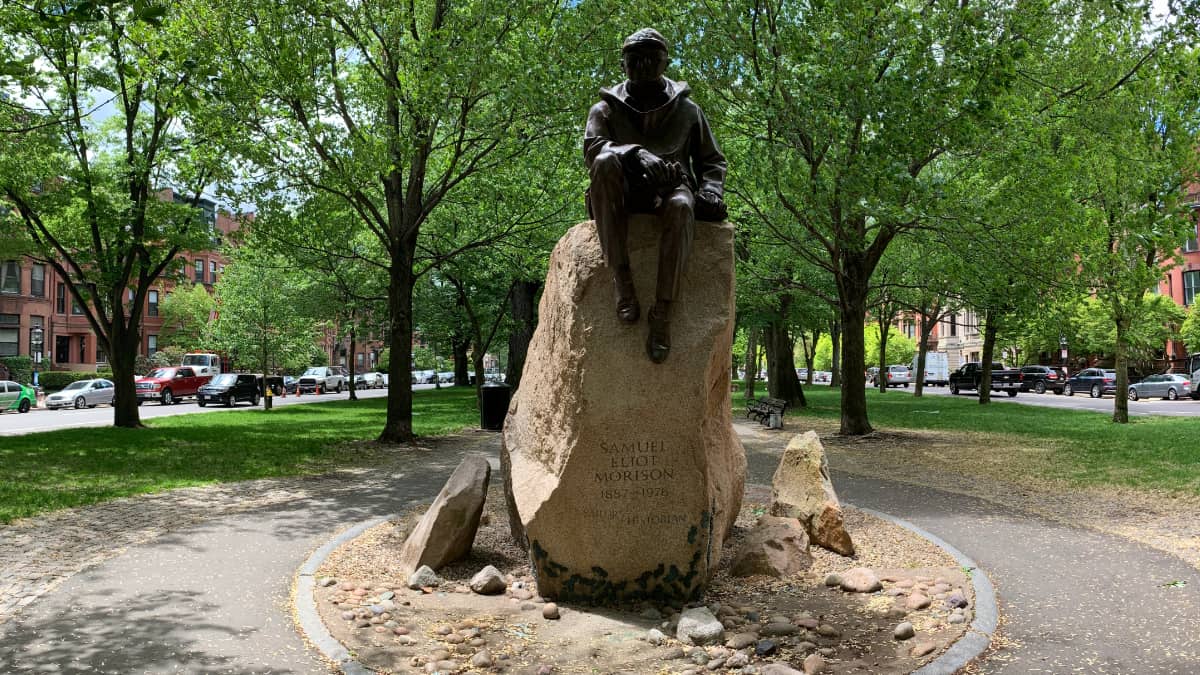
Various Fun Facts about the Statue
- The bronze statue was commissioned by the Morison Memorial Committee spearheaded by Mrs. Stella Trafford, who was the chairwomen of the Commonwealth Avenue Mall Committee of the Neighborhood Association of the Back Bay.
- The statue was funded by the George B. Henderson Foundation, there's a stone at the base to let people know.
- The statue was dedicated on October 15, 1982 (2,344 days after Samuel died)
- Emily Morison Beck, Samuel's daughter, was the person who unveiled the statue to a large crowd. She said that the location was perfect and that her father was "not looking at the sea" he was looking into history."
- Penelope Jencks was the statue sculptor. This was her first major statue. She is best known for the Eleanor Roosevelt statue in New York City.
- Samuel Morison was well known for wearing sneakers, but the statue shows him wearing regular shoes.
- He is wearing a windbreaker, a captain cap, with a book in one hand and binoculars in the other.
- He is sitting on a 20-ton granite rock from Rhode Island - as if he was looking out to sea.
- At his feet are bronze casts of crabs, shells, and starfish.
- This statue was the first one on the CommonWealth Mall to be lite up at night.
- When Samuel Morison was born in 1887, the CommonWealth Mall was just completed from the Back Bay fill. Commonwealth Ave was just an empty street with no buildings.
Additional Photos
There are two quotes around the statue:
- Dreams Dreams, Then write them aye, but live them first.
- To my readers young and old, "A flowne sheate a faire winde a boune voyage."
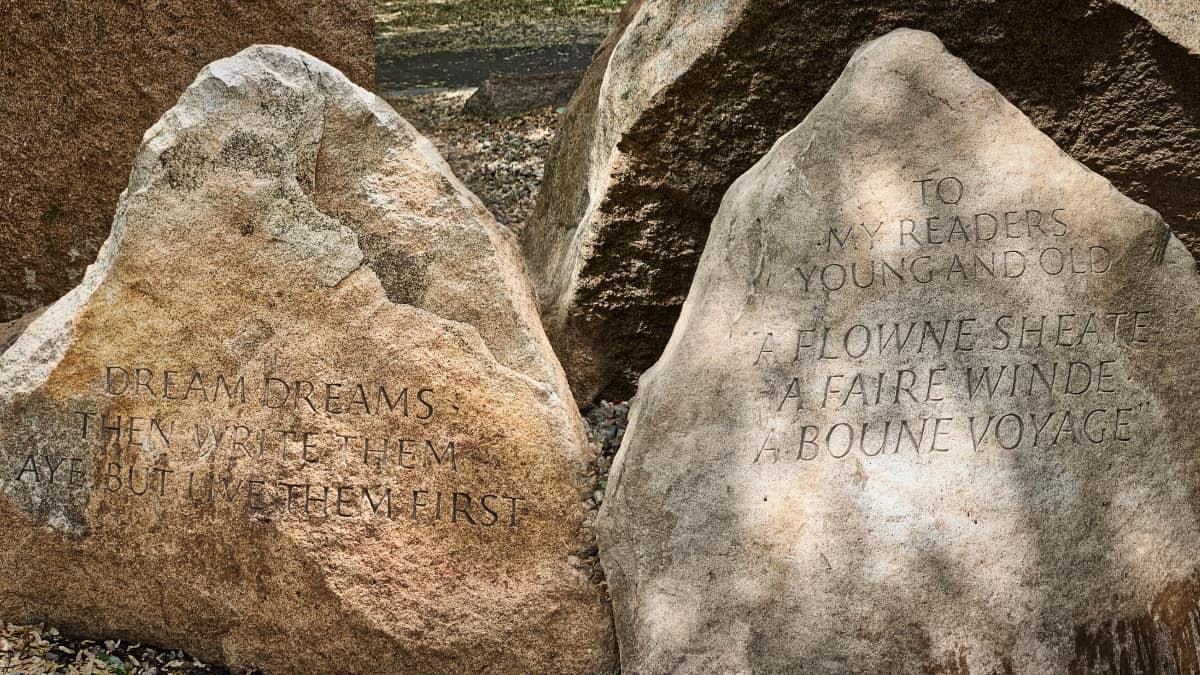
Zakim Bridge
A Bridge in Boston skyline located near the Boston Gardens
Boston's Skyline changed when the Leonard P. Zakim Bunker Hill Bridge open in 2002. The cable-stayed bridge provides a way for Route 93 traffic to get in and out of Boston crossing the Charles River.
The 16-Lane bridge is lit up usually in special colors to commemorate various charities.
The bridge is 1,430 feet long and 270 feet in height. There is no pedestrian walkway on the bridge. It is the widest cable-stayed bridge in the world.
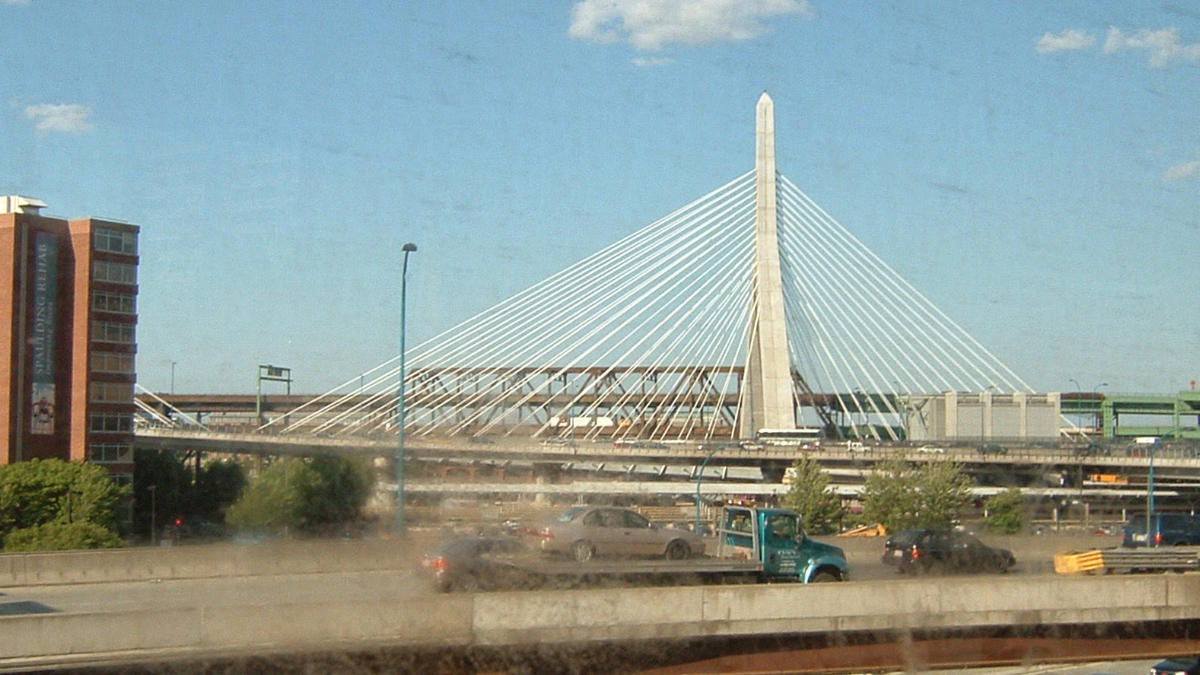
Fun Facts about the Leonard P. Zakim Bunker Hill Bridge
- The Zakim Bridge was part of Boston's Big Dig. The old bridge was the Charlestown High Bridge.
- Bridge is named after Leonard P. Zakim who was a Boston Civil Rights leader. The naming rights were disputed by locals in Charlestown as they felt the bridge should be named the "Freedom Bridge" - some locals still call it as that name.
- Construction of the bridge lasted 5-years.
- Official naming was done in a ceremony on October 2, 2002 - it was done before cars could use the bridge. (Bruce Springsteen was one of the celebrity guests)
- Opening: The northbound lanes were open in March 30, 2003 and the southbound lanes were opened in December 2003.
- Elephant: On October 15, 2002, Fourteen Elephants from the Ringling Brothers and Barnum & Bailey Circus walked across the bridge. It's estimated that they put 12,00 pounds of weight on the span.
- Lighting Cost: It cost $5,000 a month to light the Leonard P. Zakim Bunker Hill Bridge. (2009 Figures)
- Stolen Beacon Light - In 2015 a homeless man, Clifford Beckford, had twice stolen the red beacon off the top of the Zakim bridge. This is no small feat as he had to break in the tower and take the beacon which is 18-inches in diameter and measures 3-feet tall.
- Zayn Malik Bridge? - In 2015, Zayn Malik was the first band member to leave One Direction. Some fans wanted Boston to rename the Leonard P. Zakim Bunker Hill Bridge to the Leonard P. Zayne Malik Bridge. They started a change.org petition to get people to support the change. Only 50-people supported the change.
Ted William Red Chair
Fun Facts about the most famous seat in Fenway Park
One of the landmarks within Fenway Park is the lone red seat in the bleachers. The seat really stands out from all the green seats.
This seat marks the spot where on June 9, 1946, Ted Williams hit the longest home run in Fenway Park.
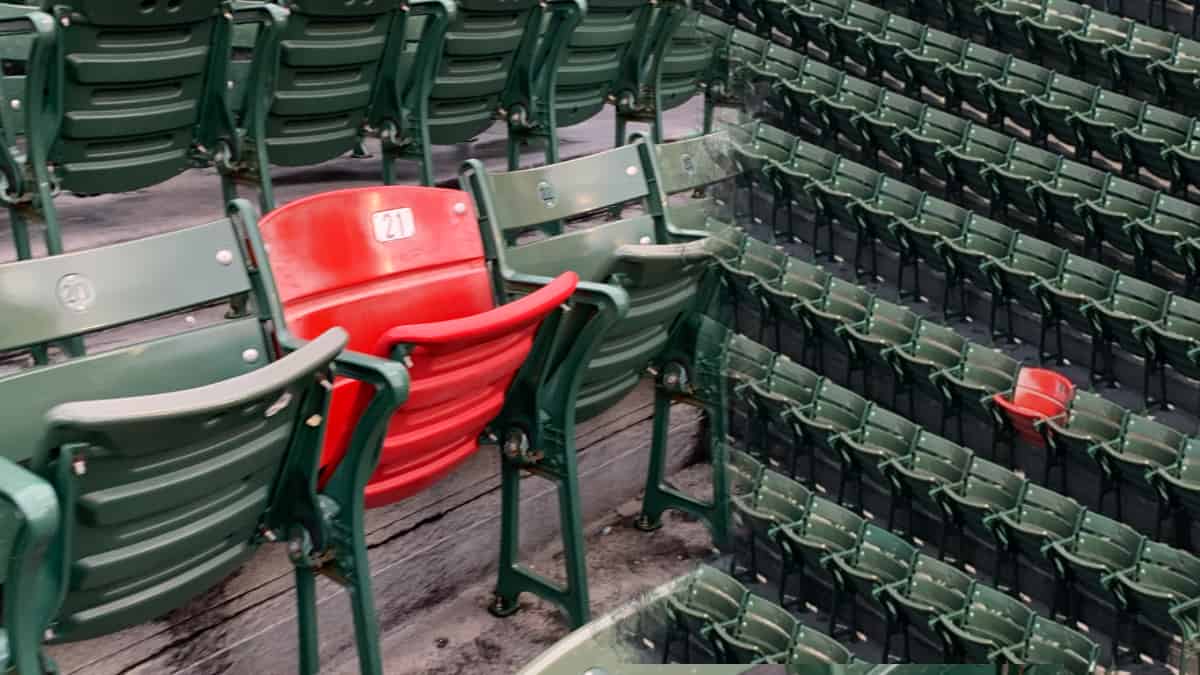
Ted William's Famous Chair at Fenway Park
Fun Facts about the Seat
Ted Williams hit the ball in the first inning of a double header against Fred Hutchinson of the Detroit Tigers.
The red seat is 502-feet from Homeplate. (When the event happened local newspapers reported it as 450-feet but was remeasured for the correct distance.)
Joseph A. Boucher was sitting in the 33rd row of the Bleachers with his straw hat. The ball hit his head and made a mark in his hat.
Officially the seat is located at Sec. 42, Row 37, Seat 21. In 1945 the seat was actually a bench.
He didn't get the ball as it bounced several rows behind him.
According to interviews after the event Joseph said that no one was standing up because the sun was blinding their sight.
Joseph A. Boucher donated the straw hat to the National Baseball Hall of Fame. (I wasn't able to find any information that it is still there.)
Over the years, the bench was replaced by seats and in 1984 the Red Sox owners changed the seat to red to commemorate Ted Williams hit.
PermalinkAbout
There are many interesting things and places around Boston, MA that you should know about. Here are a few that caught my attention. From historical sites such as the USS Constitution Museum, the Freedom Trail, and the iconic Fenway Park, to modern attractions like the New England Aquarium, the Boston Public Market, and the Isabella Stewart Gardner Museum, there is something for everyone. Whether you are looking for a fun family trip or a romantic getaway, Boston has it all.
Check out all the blog posts.
Schedule
| Friday | Macintosh |
| Saturday | Internet Tools |
| Sunday | Open Topic |
| Monday | Media Monday |
| Tuesday | QA |
| Wednesday | New England |
| Thursday | Gluten Free |
Other Posts
- Historic John Endecott's Painting and Chair
- State House Great Hall Clock
- Mather Tomb
- Top of the Hub and SkyWalk Closing
- The Ames Building
- Acorn Street
- Ames-Webster Mansion
- Love Locks on Massachusetts Ave
- Signs of Spring in Boston
- Boston's Old City Hall
- The Point Boston Sign
- Christopher Snider
- Henry Bradford Endicott tablet
- Poems of the Southwest Corridor Path
- Marvin Goody Memorial
